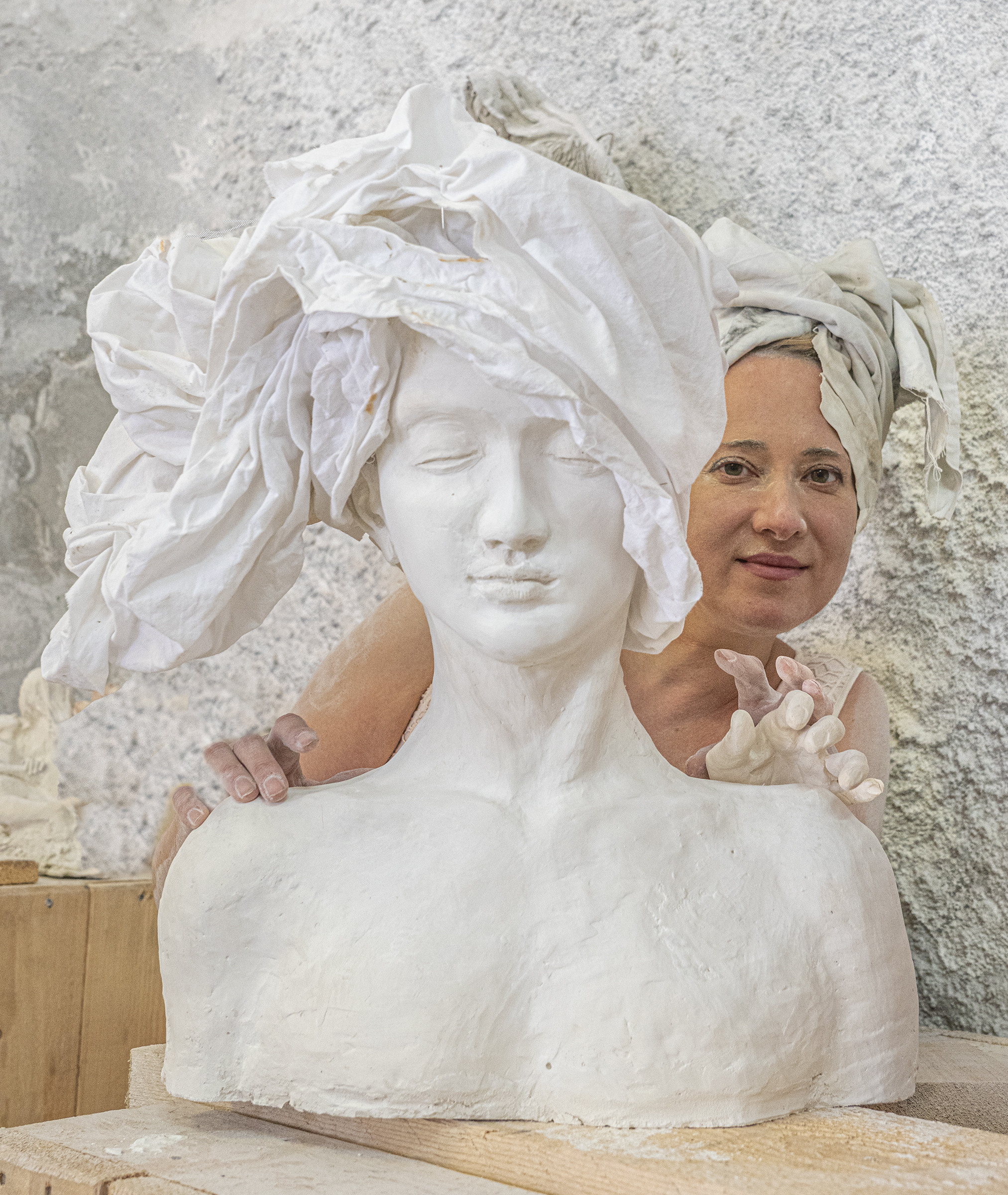
Marianna Blier, 2022
Marianna Blier was born in Astrakhan, Russia but moved to Vienna in 2007. She now divides her time between her atelier in Vienna, Austria and her marble studios in Carrara, Italy.
Eminent Californian photographer Gail Skoff introduced Marianna, and when I followed Gail on one of her photography trips, Marianna was standing on a table top, in a large workshop in the centre of Carrara. Wearing goggles and earmuffs she was leaning over a tall sculpture, carving the final touches.
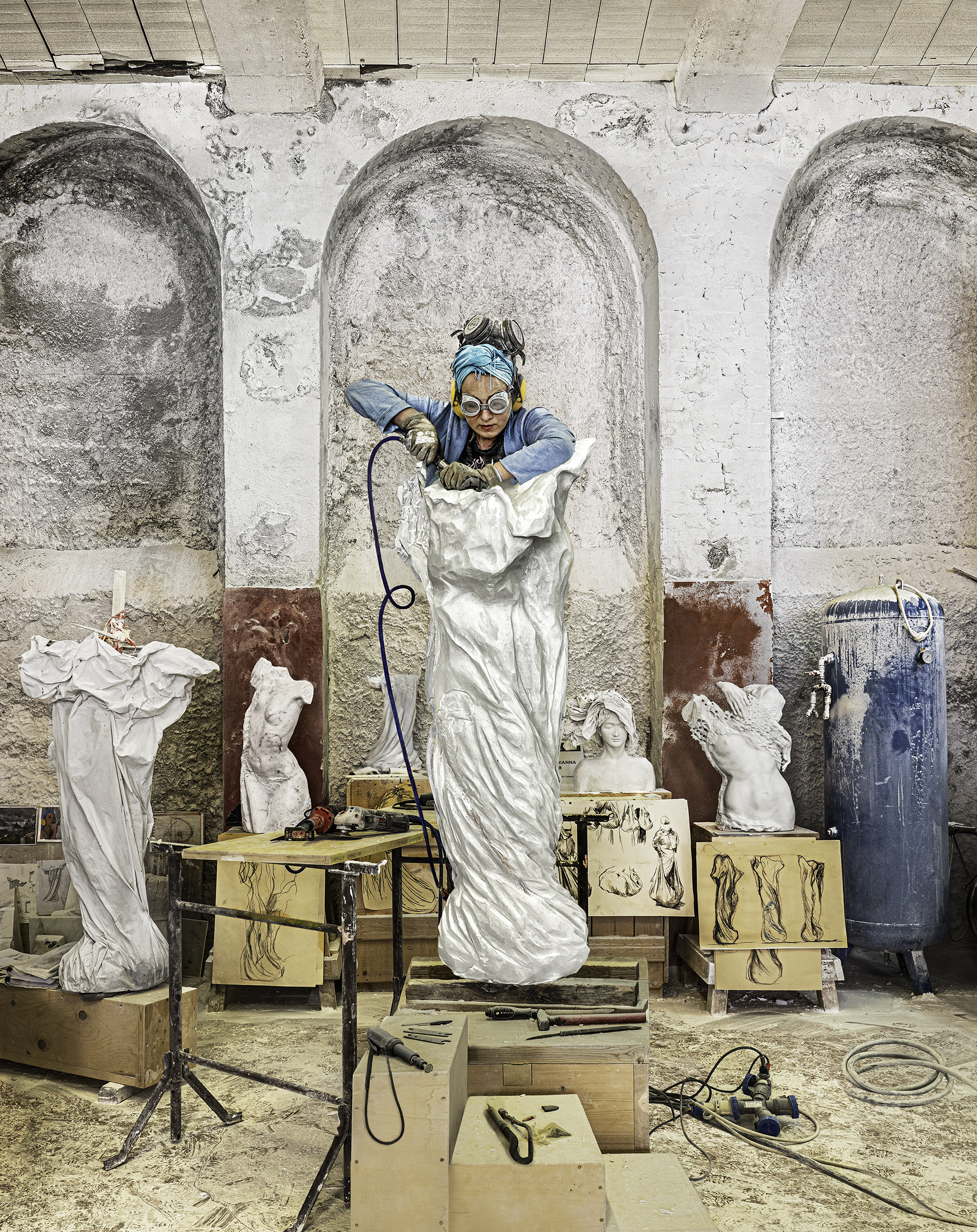
Marianna Blier, Cotton (work in progress), 2022, white Carrara marble, 150 (height) × 70 × 50 cm
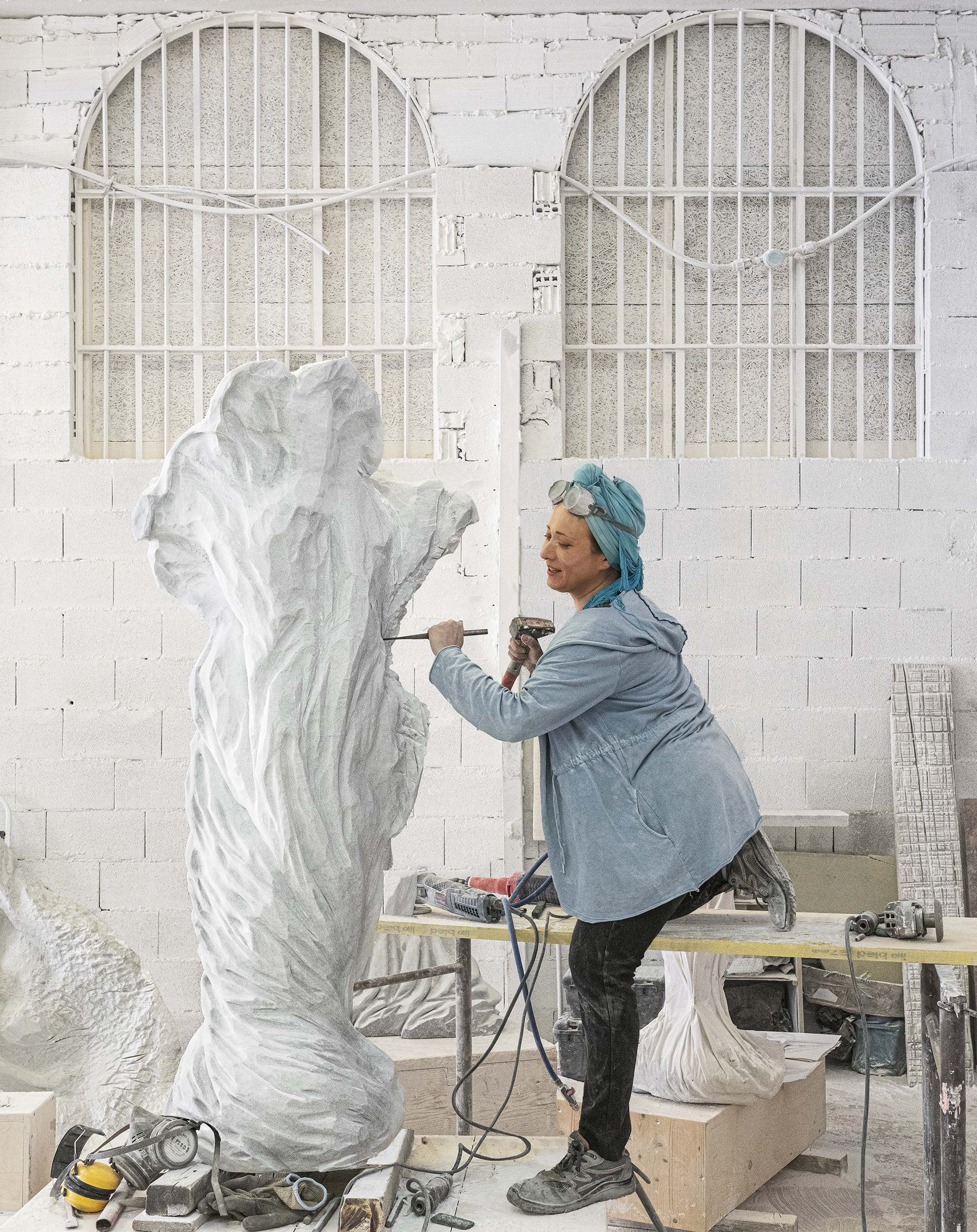
Marianna Blier, Cotton (work in progress), 2022, white Carrara marble, 150 (height) × 70 × 50 cm
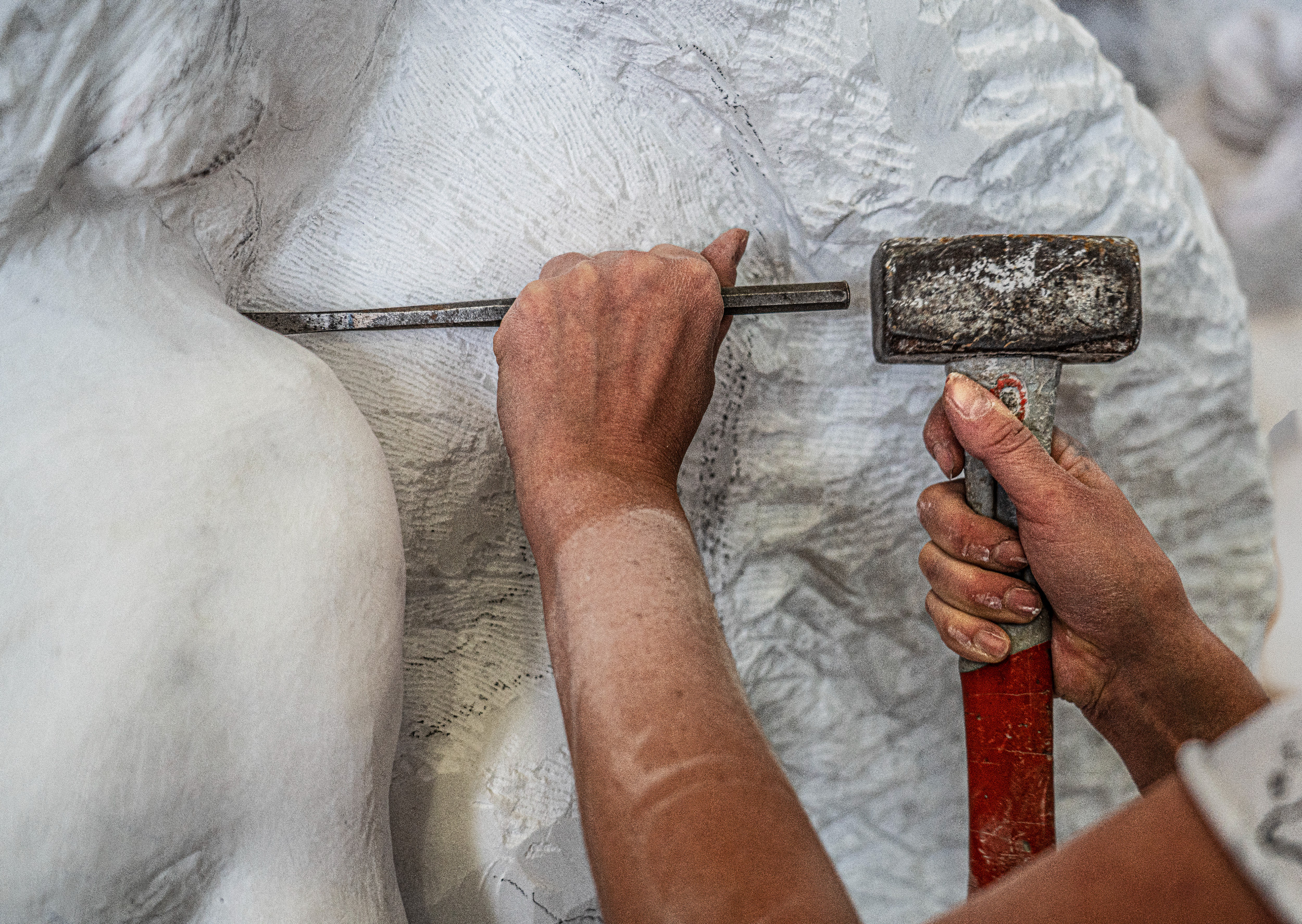
Marianna got a PhD in economics and started out in business. But her true passion was always art and finally she made the jump from finance to becoming a full-time artist.
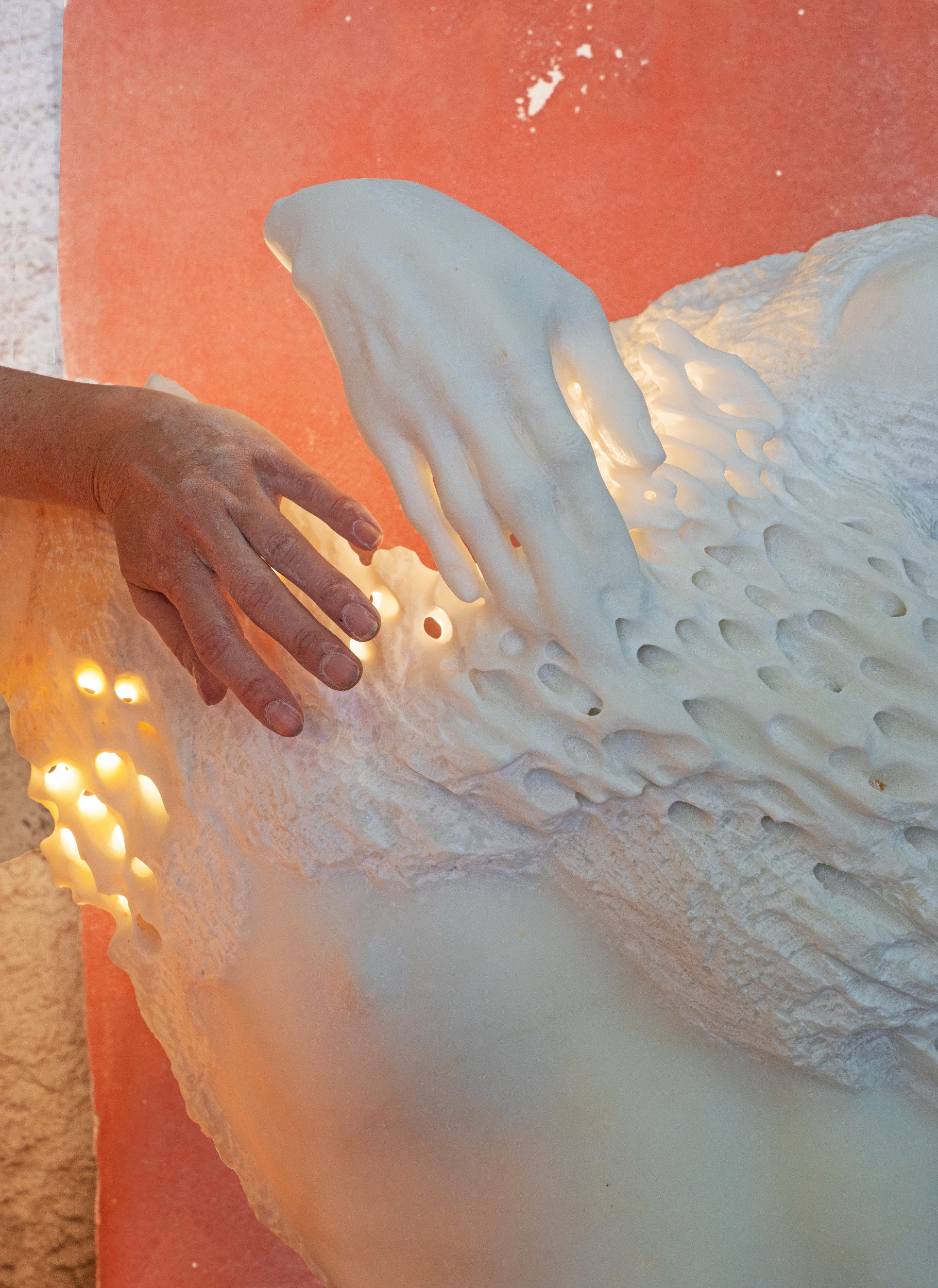
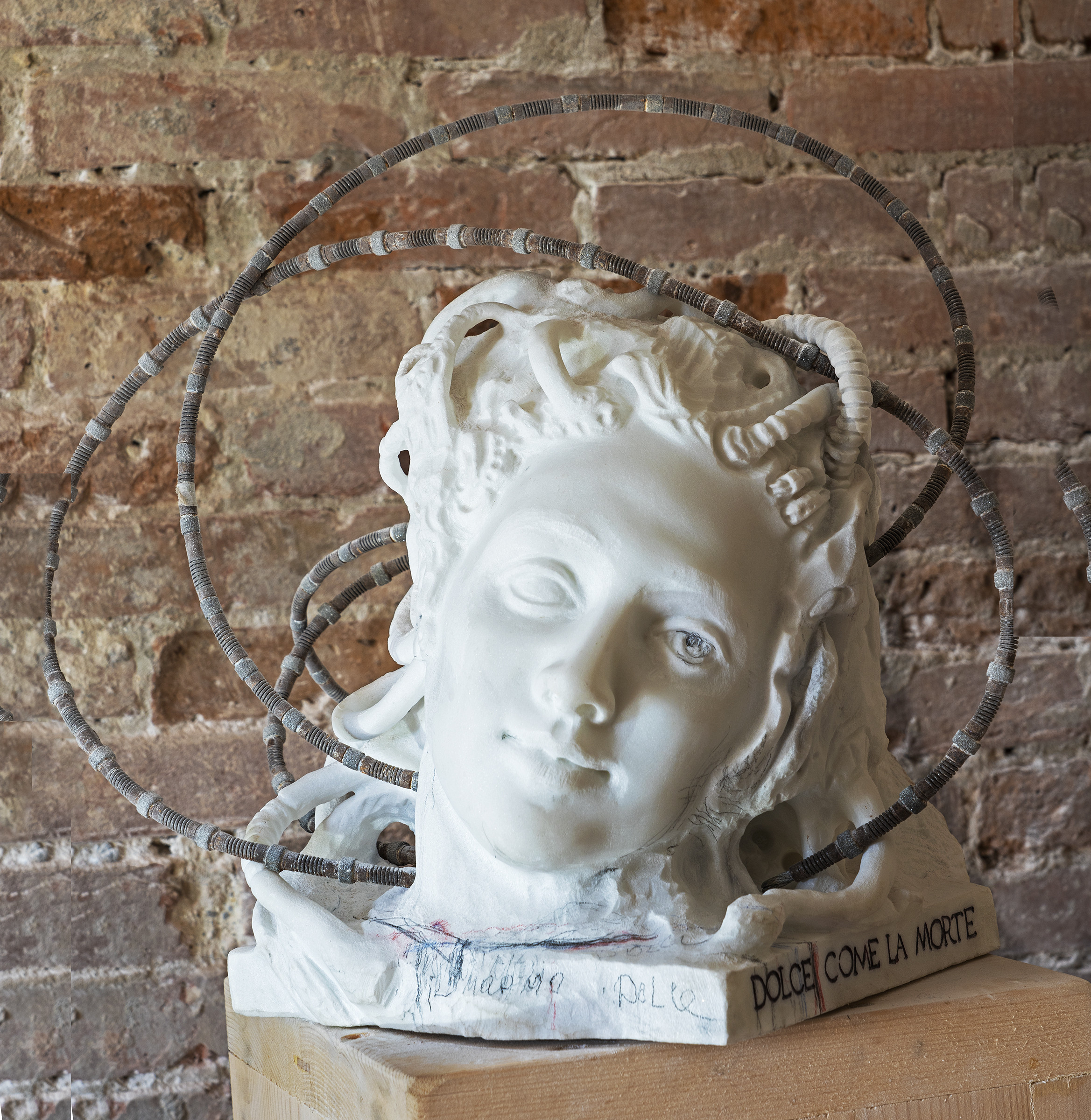
Marianna Blier, Medusa, white Carrara marble, diamond wire, 40 × 40 × 30 cm
She speaks about the importance of creativity to all people. At her Austrian company she founded a project to display the art of employees from all over the world. She continues to manage this project and tells how it played a role supporting the influx of Ukrainian refugees in the past year.
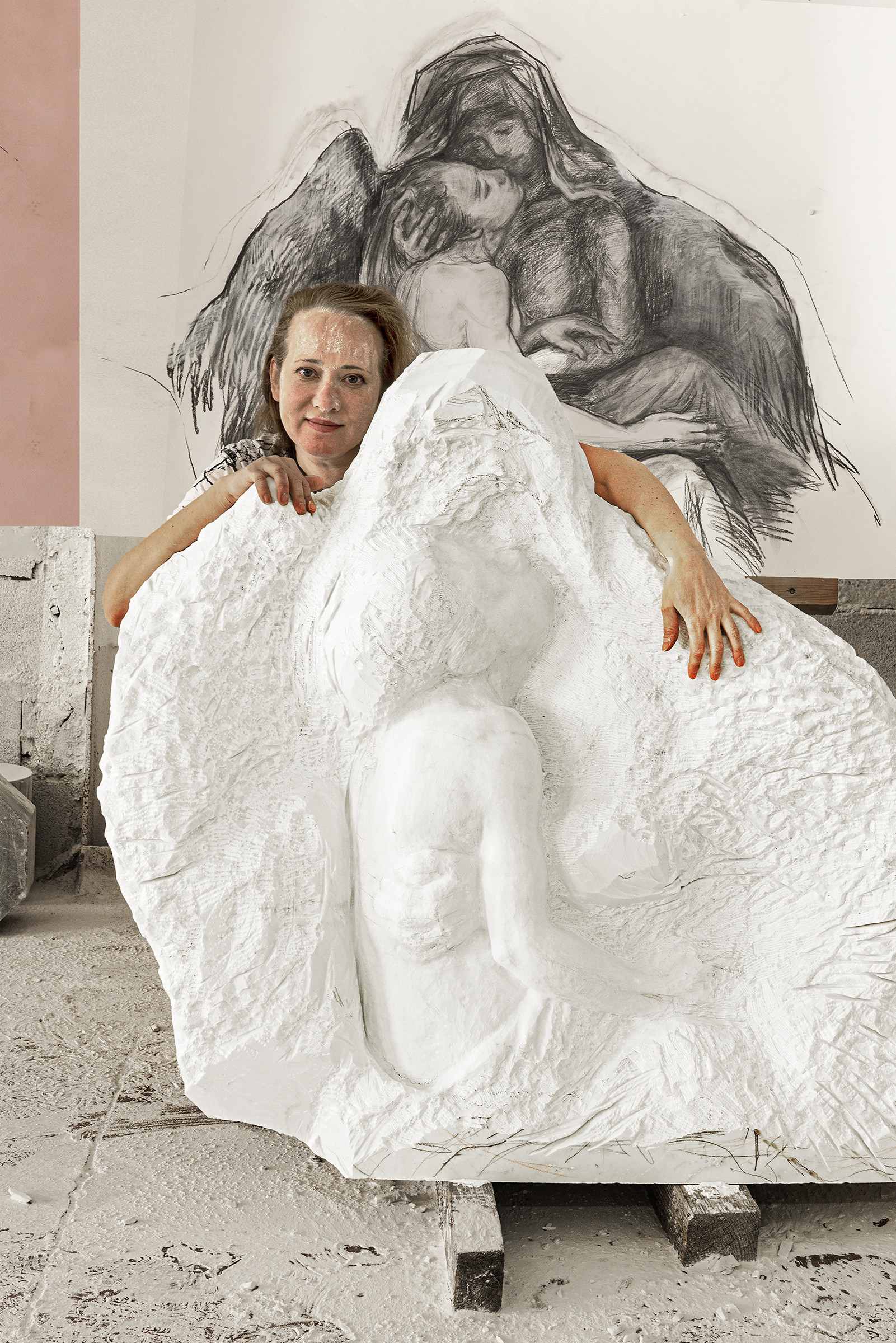
Marianna Blier, Pieta Serrone (work in progress), 2022, white Carrara marble, 120 (height) × 100 × 40 cm
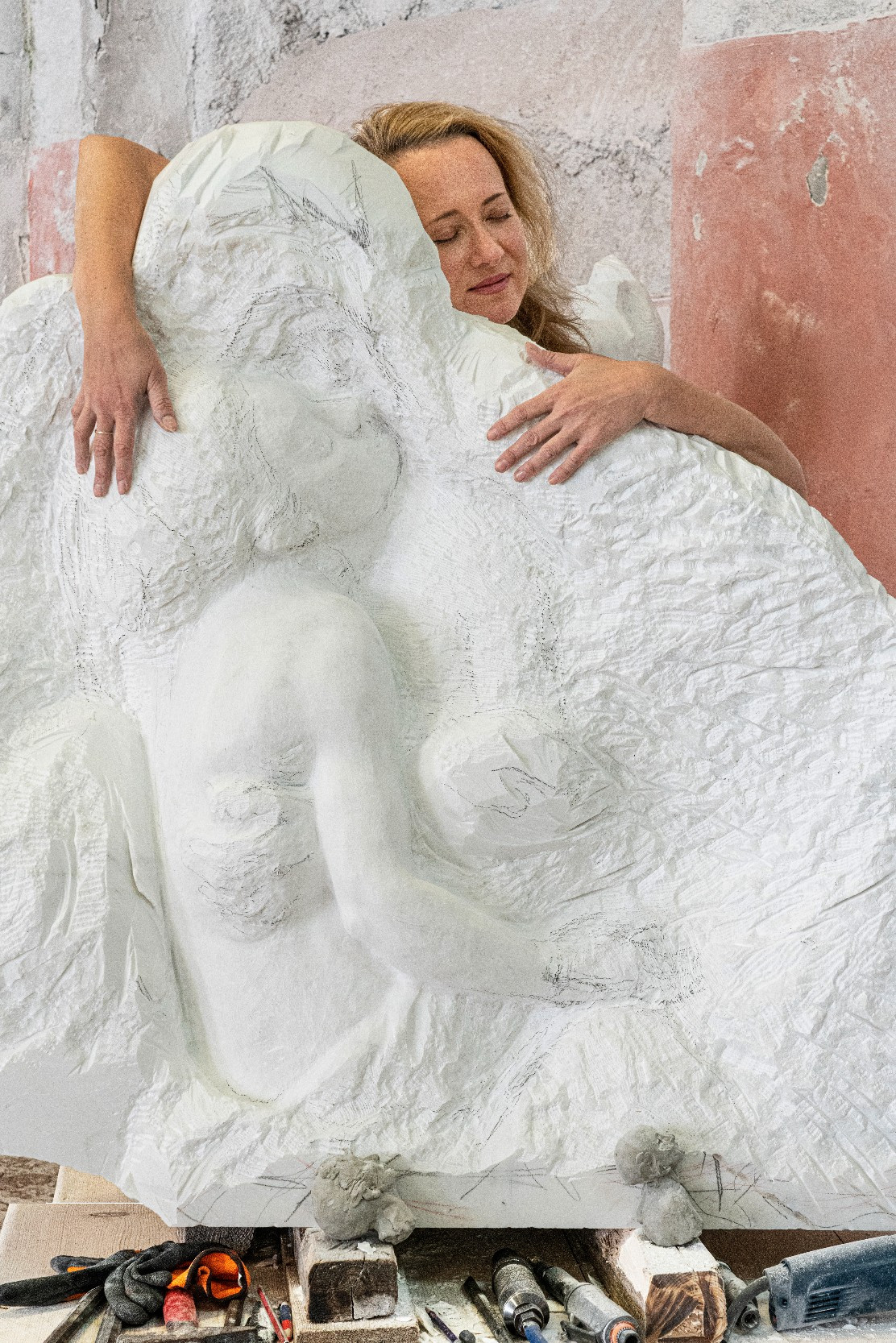
Marianna Blier, Pieta Serrone (work in progress), 2022, white Carrara marble, 120 (height) × 100 × 40 cm
Thanks to Gail Skoff for this collaboration and for the fantastic photographs of Marianna.
All photos: Gail Skoff, gailskoff.com – instagram.com/skoffupclose
Credits
Producer: Sarah Monk
Sound edit/design: Mike Axinn
Music: courtesy of Audio Network
Angel Island 2482/78, by Terry Devine-King
I was thinking when I will find a stone, then the stone gives me an idea. I just want a beautiful stone. And the stone itself, it has this shape. It was maybe not exactly the shape of this piththa mountain, but close. And it has more a shape of an angel wing.
Marianna Blier:First, I thought, oh, it’s an angel wing, but then I also saw if I cut slightly the edges, then I can see this mountain. And it was so beautifully white with this bluish like a cloud or a sky part, and plus it has this shape. I still didn’t know what I could do out of this marble. I said I want this. This was a huge stone.
Marianna Blier:I was thinking no, I still do not have enough skills and experience to work with such a big stone. And then after this, I made this sculpture hence, it was another miracle, my first sculpture.
Sarah Monk:Hi. This is Sarah with another episode of Materially Speaking, where artists tell their stories through the materials they choose. Today I’m meeting Marianna Blier, who was born in Russia but now divides her time between Vienna and Carrara in Northern Italy. I met Marianna through the eminent Californian photographer Gale Skoff, who has been photographing some artists in this area, whilst I’ve been interviewing others. Today we’re pleased to present a joint project where we have interviewed and photographed the same artist.
Sarah Monk:I followed Gail out on a photography trip and found Marianna standing on a table top in her large hangar like work shop in the centre of Carrara. Wearing goggles and earmuffs, she was bending down over the top of a tall sculpture and using a compressor powered tool to carve the final touches. Later, I met with her at her studio to talk in more depth. I asked her to introduce herself.
Marianna Blier:My name is Marianna Blier. When people hear my name, think I’m French or even German sometimes, but Blair, yes, a family name. It’s coming from my, grandparents. So I’m a very crazy mix of different nationalities, Jews, from France, Ukrainians, and Russians. So but my mom, who is Russian, by the way, she is very much in love in French culture, and that’s why she insisted that my name should be Marianna because, you know, Marianna is kind of symbol of France.
Marianna Blier:My dad, I didn’t like very much Marianna. I don’t know. He is basically more Jewish and French roots, but for some reason, he doesn’t want Marianna names, so I have the two names. He called me Jana, and a lot of my friends called me Jana. It’s totally different.
Marianna Blier:It’s more Polish name. And Blier is a yes. It’s for me, it’s very important family name. I never I was never married, but if I was married, I would never change my family name because for me, it’s a symbol of a lot of cultures that I bring in my blood, French, Belgium, also Jewish culture of Europe, then Ukrainian and Russian culture mix in there.
Sarah Monk:You live in two countries. Right? You live in Austria and in Italy. Is there anything that you bring from home from Austria when you come back to Italy? Anything you miss?
Marianna Blier:When you mentioned home, for me now, Italy is my home. I more percept Carrara. Although I was born in Russia and then lived fifteen years in Austria. And I love Austria. I love the nature.
Marianna Blier:But when I first came to Carrara almost more than six years ago, it was a feeling this is my home because it was this combination of sea, mountains, and marble. And it was the feeling that I’ve been living here all my life. When people ask what home for you, normally, the standard answer, it’s the place where you want to live. For me, it was the answer. It’s the place where I would like to die.
Sarah Monk:I wanted to ask you about your early influences as an artist. So from when you were a child, how you became an artist, whether you had artists in the family.
Marianna Blier:My mother graduated from technological university in chemistry, so she also did some research, and she was working in research institute in chemistry. And for people from this this focus on science, it was quite a surprise that I wanted to to paint. How I start was also very much strange. My first painting experience, not painting, drawing experience, was very much related to though I had no clue about Carrara. When I was a very small kid in kindergarten, my drawings and paintings were terrible and because because I probably saw a picture difference.
Marianna Blier:So when all girls were painting Barbie or princesses and flowers, I had no interest in this topic, and I was trying to draw something nobody could understand. So they were very weird abstract things. The first really serious experience was I we had a book with the sculptures of Michelangelo at home, and I love this book. And when I first saw Pieta Michelangelo, this famous Pieta, which is in Rome cathedral in Rome, I was amazed. It was a stamp in my brain.
Marianna Blier:Michelangelo Pita Carara marble. That was a certain combination of words which made me totally different person. Michelangelo Pita Cararamabal. At that moment, I understood that Michelangelo is the sculptor, and I was thinking that what he created, no human being could do. It’s just not possible.
Marianna Blier:I asked my dad what is marble. I understood, but what is Carrara? It’s a specific marble. He said, yes. It’s a Carrara marble.
Marianna Blier:It’s famous marble. It’s located in Tuscany in some region in Italy. And I had a feeling that Carrara doesn’t exist. It’s some kind of place, existed maybe five hundred years ago in Renaissance time and antique time. But for sure, now it’s just the name of this marble which is excavated in this region, but not really Carrara is Carrara.
Marianna Blier:And I was making drawings of this pitah, mostly Madonna’s face. My first serious drawings where people could see that, yes, I I can draw. So after this, my mom saw and she agreed, yes, maybe she has some talent. And she brought me basically, I insisted, but we together went to the drawing school for kids, and there is a kind of after normal school. You can visit three times per week, some art school.
Marianna Blier:And then it’s all started. And, of course, when once I saw by chance on Internet, on the Facebook advertising of sculpture courses in Carrara. I was surprised. Oh, Carrara exists.
Sarah Monk:That’s funny. So did you have a conventional art education? Did you have an education in different things?
Marianna Blier:This child art school, it was four years. It was like a normal school, three times per week, and then there’s also exams, everything. This is the only Finnish art education I have. And then, unfortunately, as I was born in the Soviet Union, then it was a collapse of the Soviet Union, very difficult economical situation. So my parents didn’t even want to to hear that I want to be united.
Marianna Blier:They said, you are stupid. You would never survive, and they will not reach. They said, no. You should go and study something useful in life. And I studied economics.
Marianna Blier:I don’t think economics are useful. But nevertheless, I put apart art, and I went to Moscow. And I was graduated from the Moscow State University. I also got my PhD degree there, but I still did art in parallel. And when I came to Vienna and my relocation to Vienna was because of my job, I was working in a big company in finance area and business development area, say.
Marianna Blier:And it was quite successful, and then some Austrian company found me through international networking. And I was asked if I would be interested to work as a business development manager in this company.
Sarah Monk:So can I ask how old you were then?
Marianna Blier:I was 26, 27 already when I moved to Austria. It became more serious in Vienna because in Vienna, I decided that I I still was not so much interested in finance and all the things. Spontaneously, a friend of mine, she saw at home at in Austria in Vienna already. She saw my paintings, and she was quite impressed. And she said, oh, let’s do an exhibition of you.
Marianna Blier:And in Vienna, it’s basically very easy. In Vienna, because people love art. And there are a lot of restaurants, cafes, some small shops. They offer place just for free. And this was such a success. I didn’t expect.
Marianna Blier:So some paintings were sold, but then what happened more important, this restaurant was visited by one woman, Art Corrata. She’s working was working for a huge IT company, but this IT company also did more professional exhibitions in their offices and also had the collection of this company. It was Oracle company. It’s quite famous, Oracle.
Marianna Blier:Then Oracle bought three of my paintings. And then I was thinking, why not maybe to think at least to stop working in finance area because I hated it in the end. I shouldn’t complain because my career was quite fast everywhere in the in Moscow then in Austria. I really traveled a lot. And even sometimes when you visit remote country or somewhere and you have to to talk about business and people have some difficulties, for example, with English language, then you always have to switch to some topics where maybe it’s easier to find a common language.
Marianna Blier:And me, it was always that. I realized that a lot of people, even who are sitting in some boring positions, doing other work, but most of them, they have something behind. It can be either painting, drawing. It can be photography. So people really need creativity, and creativity, it’s a certain thing which can unite people all over the world.
Marianna Blier:And this gave me an idea that we can in the company I work on, at that moment, we can make a project of presenting the art of employees all over the world in Vienna office. And I’m still responsible for this project. That’s that’s when I even quit my finance job, they didn’t want me to quit this project. So it’s already I don’t know. I’m not working in finance area for seven or maybe even more years, but I’m still responsible for this project.
Marianna Blier:And it’s about creativity which unite people and help people in all situations. And then then slowly slowly, I realized that this is something. And then I still did some studies for two years. I was in Vienna Academy a lot, but then I quit my job. I quit also academia.
Marianna Blier:So and I decided that I’m learning by doing. So anyway, you can’t find any I don’t know if there are any university in the world that teaches you really all techniques of sculpting and working with marble. You can only learn it being here in Carrara, taking directly from these artisans. And I have really great people who are generations of sculptors. They do not teach in academies.
Marianna Blier:They do not teach in art school, but they know the knowledge is huge. I even have an idea. I should start writing the experience and maybe leave kind of a book, more technical book of all these old techniques.
Sarah Monk:What happened to bring you from Austria to Carrara, and when did that happen?
Marianna Blier:As I said, for me, Carrara was this imaginary location of this most beautiful material in the world and where Michelangelo created this miracle theater. The most amazing work of art for me still. And when I saw Carrara, as I said, it was occasionally I saw Carrara. At that moment, I already was in Vienna, I was already in the process of quitting my financial job. Also, in this parallel, I was making my MBA, and I was writing master thesis for MBA.
Marianna Blier:I was writing about art and leadership. So my idea was to connect art and what is driving artists with what is driving leaders in business or in social life. So the these two things. And this was also a long, long work and based on interviews with a lot of artists and leaders in business. And then I took what is called what’s in English?
Sarah Monk:It’s Sabbatical?
Marianna Blier:Sabbatical. Yes. Before, I had quite a big salary. I couldn’t think about money at all, and now it was no income.
Marianna Blier:And I decided, okay. I risk. I this one year was important psychologically to prepare myself also economically. Not so easy when before you come to any shop you like and you like some dress and you buy it, even without thinking about the price. And then I yes.
Marianna Blier:My budget is like this, so note I almost now do not buy clothes or no restaurants unless somebody invites me. This was difficult. It it took me one year to prepare myself to live in a different style. And it was very interesting year with these interviews when I spoke to extremely rich people. They were very much interested about the idea that artists and leaders in business basically have the same driven points.
Marianna Blier:And one of the one of these guys quite famous in the world, I was impressed impressed that this man who can afford a lot. I mean, he’s a multimillionaire, and he said that he in general, he envies artists. And I said, why you envy artists? You you know how artists live. They sometimes they even have no money to pay their rent.
Marianna Blier:And he said, yes. It’s all true. But artists, they they have freedom. They do not have they they do have something I do not have. It’s all my money.
Marianna Blier:It is all everything. I do not have freedom. I depend on people very much. Yes. You can sometimes suffer financial issues, but anyway, you will not die of hunger.
Marianna Blier:You will find the solution. But what you have, you can’t buy for any money. It’s a freedom. And it’s not just freedom to go somewhere or to say something anyway. It’s internal freedom.
Marianna Blier:When you want to express yourself, art is the only way where you are free because it’s only you and canvas. You and block nobody else. In the moment of creation, there is nobody, and you’re free. And then I saw it was the end of the sabbatical leave. I I saw this advertising of courses in Qatar, and I decided to try.
Marianna Blier:The work in the in the beginning was hard, terrible. I couldn’t even hold this pneumatic tool. I I was thinking it will kill me, but it it was everything. Taste of marble, smell of marble, material itself, also these mountains. So when the course was over, I didn’t want to return to Vienna.
Marianna Blier:I found a studio, famous Nikolay studio in Carrara, the oldest studio. And I moved there, so I finished my sculpture in Nikola studio. And then, of course, I had to return to Vienna, but I returned to Vienna with the thought that I would relocate to Carrara. My imagination from my childhood of the most beautiful thing in art. Then the thought that art is actually this is the way to liberty or to this free freedom, real freedom, true freedom, not just freedom on of actions or word.
Marianna Blier:No. Not but really internal freedom for me to achieve it was through art. And then Kara, it was not just art, but very particular at mobile. And so it all things came together like a puzzle.
Sarah Monk:We’re talking in April 2022 with what’s going on in the world, particularly in Ukraine and Russia, and we’re all upset, obviously. How has it been for you? Do you still have family in those regions?
Marianna Blier:It’s very difficult for my family because it’s really all cultures are very important for us, and I was brought up in the family with strong Jewish traditions, a lot of influence from Ukraine. My grandmother was basically speaking Ukrainian better than Russian, but, of course, then she she learned Russian very well. And my mother is Russian, so it’s it’s a big mixture. And also being the person, from art side, and, I still think that art doesn’t have any nationality for me. Any war any war is the most disgusting thing people, can do.
Marianna Blier:It’s so much opposite to art that regardless where war, takes place in any part of the world, it’s, for me, totally unacceptable things. The first days of the war, I was so much I was crying all days, and I was really blocked. I couldn’t work. I was in the middle of a very important commission. I had to work a lot, but I stopped working.
Marianna Blier:I just couldn’t do anything. And when it all happened, I wanted to do something. And the only thing I could do is just support refugees. So the the first days I stopped working, I told the person for whom I did this commission that I need some weeks because I can’t work. I returned to Vienna, and I was trying to help kids, refugees.
Marianna Blier:I tried to be volunteer in for people who are coming, but it was maximum one day I could do it. It’s for me, was so difficult psychologically. And I understood that maybe I’m not so strong person to speak to these people to support them, so I decided to do it in the way where I’m more effective. So with a friend of mine, she’s an artist also, and she organized courses for kids who are coming as refugees in Vienna. Parents, they were in either camps, so they were searching for accommodation, and they need just to leave kids somewhere for several hours so they could do something maybe to not to to talk, not to think about war.
Marianna Blier:And there were these painting classes were great. And then because I myself manage a project of art exhibitions in Vienna, I organized exhibition of the paintings of these kids, and we called the exhibition happy place. Basically, it was coincidence with the big exhibition I already organized with adults. And a long time ago, still during pandemic, I decided to make such exhibition happy place because for artists, their studios are the happy places. And then these kids arrived, and we decided, let’s give them the topic happy place.
Marianna Blier:And the first class, was really very much impressed. They were painted Vienna. For them, Vienna was for most of them, it was the first time they saw Vienna, and they had a small excursion over the city. And what they saw, they were asked to paint how they imagined. So they took Vienna, but they painted in their, like, more fairytale places.
Marianna Blier:Especially girls, it was all pink with princesses. The boys, more boy colors, not pink. But it was so funny. So you see your own city, your home city, like, for me, Vienna. But through the eyes of the kids, for them, it’s a happy place.
Marianna Blier:Those Austrians, they could see the city they’re used to through the eyes of the kids who were in the war. Simultaneously, they were so much impressed with the kids’ painting that they bought quite a lot of painting. It’s all was donated to these families. I also heard that later some Austrian families, they wanted to be friends with the Ukrainian families who came, and it was because they also had kids the same age. And it was for them important that their kids made kids who experienced the war.
Marianna Blier:And for me, it was like, you know, these people who who suffer from certain depression. For me, war was a depression. It was the best therapy. Not to be totally disappointed in people and totally say no. The the life doesn’t make any sense.
Sarah Monk:Great.
Sarah Monk:I wondered if you could tell me about a couple of pieces that you have done recently and what they mean to you.
Marianna Blier:Well, I would highlight several pieces also because they are related. And all we’ve done recently because I started working with Carrara Marble just six, seven years ago, so and they are all not not very old. The first piece I created, was the turning point, as you remember, I said I came to these courses. Oh, I remember my first day. I went to the courses, and the teacher, he allowed me to select a stone.
Marianna Blier:Of course, they were not these huge beautiful blocks. They were just some stones in the backyard of the school. And then I saw a stone like this, maybe half a meter.
Marianna Blier:Not very big. And I had no clue what I would do because there was a task in this school, but I said I I would like to do something with what I think. And he said, no problem. And then I started working. And during working, I started seeing images.
Marianna Blier:This is my style of work with Carrara marble. Except it’s a commission, but even if it’s a sculpture I have to do, for example, a certain certain image, I still never work with the precise model. I have some idea, and I start working. But my best sculptures, I never even had anything, even drawing. I just started working, and I see images.
Marianna Blier:And my first sculpture were it was called labyrinth of hands. And this is a sculpture with a lot of hands. There are 10 hands coming from the stone. On the one hand, they shaping the stone, so they they positioned around the stone like shaping, but at the same time, they’re coming out of the stone. So they are from the stone, but they’re also making the stone.
Marianna Blier:And this is half abstract, half figurative sculpture because hands, they’re real. They’re real human hands. But at the same time, they have this abstract idea of creation or coming from the stone. So hands became number one topic in all my sculptures. For me, hand reflects more character than face, especially with today, botox and everything.
Marianna Blier:Face is sometimes it’s like a mask. But hands, you you can’t hide your thoughts with your hands. Hands is more representative representative of human. Plus, hand is a symbol of creation. But I like these challenges of hands and also how to express different emotions with hands, which is more difficult than to express emotions with face.
Sarah Monk:Another piece that I was very by, which is downstairs, is the Medusa.
Marianna Blier:First, I saw a drawing of Michelangelo. It’s in Florence in, Casa De Michelangelo. It’s the, portrait of Cleopatra. It’s a drawing of Cleopatra. History, he made this drawing for one of his students to show him drawing techniques and how to draw the beautiful face.
Marianna Blier:So he made, like, an ideal beautiful face, and he made this drawing. But some years later, it was written in many research. It was discovered that on the other side of the drawing, there is the drawing of the same Cleopatra, but as an ugly woman. So probably, it was again, it’s just guessing, but probably he was working with the student, and he was probably to show him how to turn beauty into ugliness and maybe the something like this. I was interested with this idea, and I wanted to create this woman with the snake and also may make this beautiful Cleopatra in marble.
Marianna Blier:And then it was again most of my images I see in my when I sleep in dreams. And then I saw it very clearly. This woman partly, this Cleopatra crime coming from Michelangelo, but then I saw a lot of snakes. And these snakes drew me to this story of Medusa. So I instead of Cleopatra, I saw the face with a lot of snakes, and it started becoming Medusa.
Marianna Blier:And then once I came to the studio and I saw on the floor, because I work with lot of electric tools and their cords were like like snakes, and also the pipes from, the compressor because I always work surrounded by the snake. So it was an image like this, and I use these tools, parts of tools, pipes as a snake on her head.
Sarah Monk:Can I ask about which tools? Because I remember there were two.
Marianna Blier:If you work with a compressor, to work with a pneumatic hammer, this pneumatic hammer is attached to the compressor with this plastic pipe. And then this plastic pipe, when you work, for example, at the same time with two different pneumatic tools and also with this drilling tool, which is also works on compressor. Then I work with several together, and these pipes, they always becoming like snakes. Last, then the story of Medusa itself. If you know the story, so there was once a beautiful name for goddess of woman.
Marianna Blier:Her name was Medusa, and the god of the sea fall in love with her, but she didn’t want this. So, basically, he raped her. But she because she wanted to escape, she hide in the temple of Athena. It was a big goddess. And Athena, instead of protecting her, she was quite angry because they used her temple for for raping.
Marianna Blier:So instead of protecting her, she even made her life first. She turned her into monster. Not into monster, but into medusa. So she still was beautiful, but instead of hair, she had the snakes. And plus, she killed people with her eyes, but not really killed.
Marianna Blier:I don’t know why there was such a strange punishment with snakes. I can understand, but still what Athena gave her is this killing power. She turned people who looked at her, she turned into stone. So it was not killing. They will not die.
Marianna Blier:They became stone. They became sculptures. And this for me was interesting. I said, wow. But it’s exactly what I’m doing.
Marianna Blier:I’m turning people into stone. So it’s also kind of hidden self portraits.
Sarah Monk:That’s great. And can you remind me there’s an inscription. What’s the inscription around it?
Marianna Blier:There are two phrases, so you can read this one or basically there are two. First, it is in Italian. First, it is which is translated soft as a marble. But tenera also in Italian, it means soft and it means tender. So it is double meaning.
Marianna Blier:So for me because for me, marble is not hard materials. It’s very soft and it’s very tender material. So this is one part of the phrase, and then it becoming the other, but it can be written together. Sweet like the death. And but also you can read So the idea that marble is a suite like this, but this, again, it’s related to this ability not to kill but to turn into stone.
Marianna Blier:So this, it means that something is becoming a sculpture.
Sarah Monk:You talked about the mountain there out of your bedroom window and how what has inspired. Could we go back to that?
Marianna Blier:So when I did this sculpture with hands, I was ambitious to start something bigger. I was thinking when I will find a stone, then the stone gives me an idea. I just want a beautiful stone. And the stone itself, it has this shape. It was maybe not exactly the shape of this Piththa mountain, but close.
Marianna Blier:And it has more a shape of an angel wing. First, I thought, oh, it’s an angel wing, but then I also saw if I cut slightly the edges, then I can see this mountain. And it was so beautifully white with this bluish like a cloud or part, and plus it has this shape. I still didn’t know what I could do out of this marble. I said, I want this.
Marianna Blier:This was a huge stone. I was thinking, no. I still do not have enough skills and experience to work with such a big stone. And then after this, I made this sculpture hands. It was another miracle, my first sculpture, and I brought it to Vienna, I exhibited it in the gallery.
Marianna Blier:And there was one visitor, a guy who said he liked it, but I didn’t want to sell my first culture. But this was the guy who was my first commissioner. He said, okay. I understand you don’t want to sell this, but make something similar for me also with hands, but he also wanted a face, and he was also a person very much interested in philosophy. And he wanted to create a sculpture which symbolized free will and his own ideas about freedom to make a choice.
Marianna Blier:And then after this commission, there were some more. So anytime I finished something, there were people who would like me to do something for them. So I had to postpone to return to this big sculpture. But anytime I postpone, I became more and more experienced. So it’s already past six years.
Marianna Blier:And now I feel the forces to do, and I very clear see what I want do. So, yes, I see the image of pita, but also image very much related to Michelangelo pita and very big reference to his pita. But his pita is this traditional woman holding a man. In in my case, it will be two women. So first of all, I want to break this tradition that the Christ is man, and it’s not basically in particular about this story about Christ.
Marianna Blier:It’s the story of sacrificial of any person and the story of relation between two loving people. It can be mother and son. It can be mother and daughter. It can be two sisters. So for me and also especially now when, this war happened, this image of a person who is dying and hence, and the other person is holding the person whom he loved or she loved.
Marianna Blier:So gender doesn’t matter. And maybe it’s not even two persons. It’s one person, but maybe in different stages. So, like, one person who part of this person is internally died and the other part is holding. So it’s it’s more about the reflection of this self story.
Marianna Blier:So there will be two women. One is more realistic. The other is more abstract becoming a mountain. You can also interpret it as a mountain holding a person. So for me, Karara Mountain was this supporting power which holds me as an artist, which holds me as a person, which gives me a forces to live.
Marianna Blier:So this stone was my first stone brought from Kyiv and it was waiting for me all these years. And now I’m ready to make this sculpture.
Sarah Monk:So this is the story.
Sarah Monk:That’s fantastic.
Sarah Monk:So thanks to Marianna Blier. You can see her work on her website, mariannablier.com, or on Instagram, @bliermarianna. Thanks too to Gale Skoff, whose photographs of Marianna can be found on our website, materiallyspeaking.com, and on Instagram.
Sarah Monk:You can also check out more of Gail’s work on her website, gailsckoff.com, and of course on Instagram, @skoffupclose. Thanks for listening, and if you’re enjoying Materially Speaking, subscribe to our newsletter on our website, so we can let you know when the episode goes live.